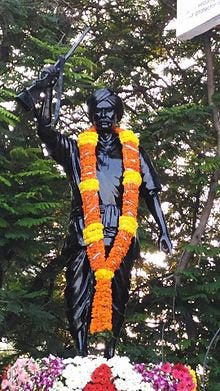Komaram Bheem was a freedom fighter who led an intense uprising against both the British and the Nizam rule in the jungles of North Telangana, with his slogan of Jal, Jangal, Zameen.
The Gonds are the largest tribal community spread out primarily over Central India and Odisha, their name is believed to have come from the Telugu word for hill, Konda, much like the Khonds of Odisha. Their society is divided into patrilineal units called sagas, whose number depends on the region they are located in. The Gonds living in Telangana are divided into four sagas called Yerwen, Sarwen, Siwen and Nalwen whose name indicates the number of ancestors they had. Like most of the tribes, they too carried out revolts against the British, over the exploitation of forest resources.
Bheem was born in Sankepalli, a small hamlet in the Mandamarri mandal of Adilabad district on October 22, 1900. Growing up in the forests of North Telangana, he received no formal education, and led a nomadic life. It was the period when restrictions were imposed on the subsistence farming practices of the Gonds. The Zamindars who took over their lands imposed taxes on podu farming and tribal peasants who failed to comply had their arms cut off. The exploitation by the Zamindars, along with the jangalaat( forest police), and contractors, forced most of the Gonds to move out to other places, with occasional protests.
Bheem’s father was killed during one such protest, following which he moved out along with his family to Sardarpur near Karimnagar.However they still had to face the exploitation by the local Zamindar Lakshman Rao, who forcibly extracted taxes from them. During one such confrontation in October, 1920, he killed a senior officer of the Nizam,Siddique who was forcibly confiscating the crops during 安曇野 ペンション ハーヴェスト Pension Harvest escape arrest, he ran away by foot to Chandrapur, with his friend Kondal. They were granted refuge by Vithoba, who ran a magazine that propagated revolt against the British and the Nizam, where he learnt to read, write and speak in Hindi, Urdu, English.
However with Vithoba’s arrest, he once again escaped this time to a tea plantation estate in Assam, with the help of one of his friends at Mancherial station. Working in the plantations for four and a half years, he began to take an active part in the union activities for which he was arrested. He managed to break out from prison within four days,and returned to Balharshah, boarding a goods train. Hearing of the Rampa revolt by Alluri Sitarama Raju in 1922, and the tales of another legendary freedom fighter Ramji Gond,he decided to initiate his own struggle for the Gonds of the region. He moved to Kakanghat with his family and began to work for the head of the village Lacchu Patel, whom he helped in a land litigation case against the Asifabad estate, that bought attention to all the tribals living in the villages nearby.
He married Sombai, and moved to Bhabejhari in the interiors, settling down to cultivate the land there. When forest officials threatened him to leave the land during harvest time, saying it belonged to the Nizam, he decided to negotiate peacefully and also present the grievances of the tribals. However when the peaceful negotiations failed to achieved any result, Bheem decided that armed revolution was the only way out.Associating himself with the banned Communist party, he began to mobilize the tribals at Jodeghat, and called for a meeting of the council of leaders from the 12 traditional tribal lands of Ankusapur, Bhabejhari, Bhimangundi, Chalbaridi, Jodeghat, Kallegaon, Koshaguda, Linepatter, Narsapur, Patnapur, Shivaguda and Tokennavada. The council concluded that an armed guerilla revolt was the only way out against the Nizam rule, and also proposed a plan to create an independent kingdom of Gondwana.
The uprising began in 1928, when the Gonds attacked the zamindars in Babejhari and Jodeghat. Though the Nizam offered assurance of land grants, Bheem categorically rejected the proposal, and demanded regional autonomy for the Gonds, eviction of all forest officials, zamindars and release of all Gond prisoners. With the state rejecting the demands,it led to a long guerilla campaign for close to a decade, where Bheem leading a force of arond 300 men, regularly attacked the Nizam’s army in ambush attacks harassing them. However Bheem was eventually betrayed by one Kurdu Patel, and was shot dead in an encounter on October 1940. Another hero’s voice fell silent.
Komaram Bheem has become an icon among the Gonds, whose death anniversary is celebrated by them on Aswayuja Powrnami at Jodeghat, annually. The revolt of the Gonds would ultimately lead to the Telangana Revolt against the Nizam much later.
Source- My blog post here



